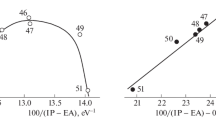Abstract
The reaction course of aldol condensation has been studied. Diacetone alcohol is produced from acetone, using a basic ion exchanger as a catalyst. Experiments are carried out in a laboratory set-up (batch process). The analysis of reactants and products is made by the method of refractometry and gas chromatography, respectively. The reaction is performed at 293, 303, 313 and 323 K. Reaction course is determined with respect to temperature, experiment time, method of analysis and catalyst preparation (freshly prepared or regenerated). Reaction rate constants were calculated.
Abstract
Исследовали ход реакции альдольной конденсации. Используя основной ионообменник в качестве катализатора, из ацетона был получен диацетоновый спирт. Исследования проводились в лабораторных установках (непроточный процесс). Анализ исходных соединений и продуктов проведен с помощью рефрактометрнн и газовой хроматографии, соответственно. Реакцию проводили при температурах 293, 313, 303 и 323 К. Ход реакции исследовали в зависимости от температуры, времени протекания и природы катализатора (свежеприготовленный или регенерированный). Рассчитывали константы скорости. цеолиту HZSM-5 (без редокс активного компонента) была достигнута в 15 раз более высокая селективность к C2 альдегидам. Исходя из результатов ИК поверхностных комплексов, возникающих при взаимодействии метана с протон-донорными местами при 400°C, делали заключения о возможном механизме данной реакции.
Similar content being viewed by others
References
A.A. Frost, R.G. Pearson: Kinetics and Mechanism, p. 335. John Wiley, Toppan Co, Ltd, Tokyo 1961.
W.E. Nelson, J.A. Butler: J. Chem. Soc. I, 957 (1938)
A. Garcia Raso, J.V. Sinisterra: React. Kinet. Catal. Lett.,18, 33 (1981)
Mitsubishi Chemical Industries Co. Ltd., Jpn. Kokai Tokyo Koho, J.P. 57.128.650, Aug. 10, 1982.
Jpn. Kokai Tokyo Koho, J.P. 61.259.756, Nov. 18, 1986.
J. Barrios, J.H. Marines: Bull. Soc. Chim. Bulg.,95, 107 (1986)
B. Jávor, T. Mándy: Hung. Pat. HU 38.089, Ápr. 28, 1986.
C.J. Schmidle, R.C. Mansfield: Ind. Eng. Chem.,44, 1388 (1952)
M.J. Astle, J.A. Zaslowsky: Ind. Eng. Chem.,44, 2869 (1952)
Z.N. Verkhovskaya et al.: Khim. Prom.,43, 500 (1967)
Ju.Ju. Cmur, I.V. Smolanka: Ž. Prikl. Khim.,39, 1675 (1966)
H. Matyschok, S. Ropuszynski: Chemia Stosowana,XII, ZA 283 (1968)
H. Spes: Ger., I., 285, 170, April 3, 1969, CA,70 (1969) P 115856 w
R. Kunin, AMBER-HI-LITES (Rohm and Haas Co.), No. 127 (1972)
Idem R. Kunin, Ibid. AMBER-HI-LITES (Rohm and Haas Co.), NO. 128 (1972)
A.P. Khardin, V.A. Navrotskii, V.G. Samilov, V.V. Pozdnev, L.I. Kutyanin, A.Sh. Lukmanov, V.G. Sidorov, S.A. Zhukov: USSR SU 963.983, Okt. 7, 1982.
N. Sišul, Ph.D. Thesis, University of Zagreb (1978).
Author information
Authors and Affiliations
Rights and permissions
About this article
Cite this article
Sišul, N., Ciković, N., Jelenčić, J. et al. Contribution to the study of the aldol condensation process. React Kinet Catal Lett 40, 227–233 (1989). https://doi.org/10.1007/BF02073798
Received:
Accepted:
Issue Date:
DOI: https://doi.org/10.1007/BF02073798




